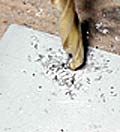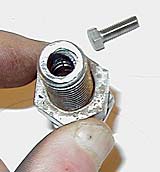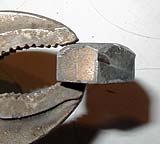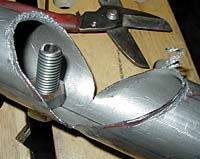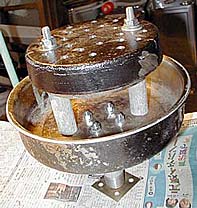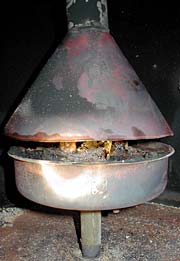Yesterday was the first real day of spring, it was 20 deg C (68 deg F), sunny, insects flying everywhere and fruit trees blossoming... And I finally figured out how to keep our house warm in the winter. LOL! Well, we get there in the end.
With similar wonderful timing, last year at just this time I finished building our first Mother Earth News heater, the original design:
It worked really well with kerosene and with biodiesel, but it wouldn't burn the biodiesel glycerine by-product, which we'd hoped it would do, but it quickly coked up. It did burn WVO (waste vegetable oil, used cooking oil), producing plenty of heat, but again it coked up quite quickly. Feasible, but too much cleaning involved.
So I turned to Bruce Woodford's adaptation, which uses a forced air supply via a squirrel cage fan and a different burner design. Bruce says it reaches about 600-700 deg C (1,100-1,300 deg F) at the stovetop, a lot hotter than the original design, and it's obviously much hotter than that in the burner itself. (See Bruce Woodford's forced-air waste oil heater and Plan)
It's great for waste motor oil -- Bruce and his friends were unconcerned by the warnings last year from Richard Freudenberger, the original designer, that additives had raised the burning temperature of motor oil since the heater was designed and as a result it was no longer suitable for burning used motor oil. (See Note.)
But I had doubts it would burn the glycerine by-product, or at least give a clean and continuous burn without getting gunged up with a refractory soap residue. The elusive goal. Prof. Michael Allen told me he thought it needed a burning temperature in excess of 1,000 deg C (1,800 deg F) "and you will probably need a mean residence time in the Hot Box of about 5 seconds". And perhaps pre-heating and atomisation as well. See Burning glycerine
I followed Bruce's instructions carefully, but the new burner (right) didn't even like biodiesel, and it just went out when I tried WVO, let alone the glycerine by-product, though it worked well with kerosene. I decided that, no matter how well it might work with fossil fuels, the burner was all wrong for biofuels -- biofuels have much higher flash-points. I substituted the double frying-pan burner from the original design, fashioned a conical hood for the 2" forced-air supply pipe to fit over it, and tried again.
This worked very well with biodiesel, but much less well with WVO, so I didn't even try glycerin by-product. I made a 50-50 blend of WVO and biodiesel, and that worked just fine. I was testing it in the open backyard between the kitchen and the shed (workshop), it had been snowing and it was very cold, but it warmed the whole yard up, I had to take my coat off.
But, while we always have more WVO than we can use, plenty for winter heating fuel, I don't want to be making high-quality biodiesel all winter just for heating. The cost works out at not that much less than kerosene, which is about half the price of petroleum diesel fuel in Japan, and with time and labour added it's not worth it.
The main biodiesel cost component is the methanol. We get a good deal on it but it's still not cheap, and we can't get it any cheaper because there are restrictions here on how much you can store onsite. With 20% methanol needed to make the biodiesel, a 50-50 mix of WVO and biodiesel uses 10% methanol, too much. So I made some "biodiesel" with 5% methanol, using the single-stage base process and the titration amount of lye but with only 5% methanol. The glycerine by-product separated as it should, but not as much as usual and it was sludgier than the usual by-product.
But the fuel worked -- definitely not something you want to put in your car, but it burned very well in the new burner. I burned it for a few hours, with an amazing amount of heat output: it was outside and there was a frost, but the lower half of the heater was red-hot. And there was no ash or sludge buildup in the burner.
Maybe I can get that 5% even lower, down to 4% methanol or maybe less, but this is feasible as winter heating fuel. The fuel is just for heating, not driving, so there's no need to wash it. Quick and easy. We have enough excess methanol to recover from stored by-product to make about 600 litres of this bioheating oil, lots of winter heat essentially for nothing. See Bioheating oil
We've been using a small woodstove in the kitchen, which works well, it made all the difference in the cold months (and we have plenty of wood here), and we'd planned to put the WVO burner in the kitchen too, but it burns much too hot to have it inside the house. We'll have it outside instead, mounted inside a 200-litre oildrum, with a second fan blowing air into the oildrum and outlet pipes leading into the house under the floors and into the rooms. That will keep the whole house warm.
Keith Addison
Journey to Forever
8 Apr 2005
Left: Yet another 90-litre tank from a junked kerosene water heater. Above: Cut out the door (big enough for the burner unit to fit through). Above right: Use the cut-out as the door. Cut a steel backing from another tank, the opening 3/8" less all round than the door space. Right: Cut a hole in the door for the viewing window. Above: Drilling the holes to bolt the backing plate in place inside the door. Cut a shutter for the viewing window, 3/8" bigger all round than the window. Drill holes for hinge bolts, then countersink the holes on the inside (above left), so that the bolt is flush-fitting (above right and far right). Bolt the hinge on (left). Cut another strip of steel to fit under the other side of the hinge, and countersink these holes too. Bolt the hinge on, bolt the whole assembly to the door over the window. Cut another piece of steel for the other side of the shutter and bolt it to the door with clips to hold the shutter closed. Bolt two hinges to the door the same way. Bolt the backplate to the tank, with more clips to hold the door closed, and bolt on the door hinges. Detail below left. (We fitted more clips above and below the door later.) Maybe we could have used an ordinary plumbing tee-junction for the air-supply pipe (see Plan), but we used 2-inch car exhaust pipe instead of water-pipe, it didn't come with threads and we don't have a die for threads that size, so we did it another way. Above, above right and right is the drilled-out bolt we made to hold the fuel line in place in the top of the air-supply pipe, with a threaded hole cut in the side of the bolt head for the holding bolt. The nut, left, has to be rounded off to fit snugly inside the 2" pipe. Make a template (left) for a right-angle cut in the pipe -- it will have to be a bit less than 90 degrees to allow for overlap. Right and far right, fitting the template -- note the overlap at the top, to leave you a bit of the pipe to bend. Drill a hole for the fuel-line fitting, far left. Screw in the fitting, left, and fit the rounded nut inside the pipe, right. Above: File the V's deeper. On the left side, bend the edge of the pipe out, on the right, bend in at first and then out. Trim off any excess. Above right and far right: Carefully bend the pipe into a right-angle, tucking one side inside the other -- if you've done it right, they'll clip together firmly (left).
Top right: Cut off the tank fittings for the lid and the filler gauge; cover with flat metal plates screwed into place. Right: Cut the hole for the 2-inch air-sipply pipe in the centre of the tank; leave tabs and bend them up to secure the pipe in position. Cut a hole in the side of the tank for the flue.Above: Fit the pipe to the tank and clamp it in place round the upaised tabs with a stainless steel hose-clamp. Left: The flue is fitted the same way, along with some screws. Seal with refractory cement. The burner
For use with biodiesel or bioheating oil, the heater uses the same burner as the original Mother Earth News design. The base of the burner unit is an 8" stainless steel frying pan with the handle stub ground off and the rim cut back. It stands on two steel plates with a 4" length of 1" water pipe between them. The 3/8" round steel burner plate is just less than six inches across and is perforated with 5/16" holes. It's supported by two 3-1/4" lengths of 1" steel water pipe held by "redi-bolts". The top of the unit is an inverted 6" cast-iron skillet with the handle cut off, perforated with 5/16" holes. It's held above the burner plate by two 1" lengths of 1" steel water pipe. The whole unit bolts to the floor of the heater. The air- and fuel-supply is from above, with the air-pipe ending in a conical hood above the burner. See How to build a funnel.
Left: The burner in action, with the hood lowered -- still hot after turning the blower off. Make the hood so that it will slide up the air-supply pipe to give access to the burner. Using the heater
Position the fuel tank higher than the heater for gravity feeding. Open the heater door, raise the hood. Fill the lower frying pan with perlite. Add a couple of hundred millilitres of kerosene and light with a match. Close the door, open the view window, turn on the blower, open the valve on the fuel tank, adjust to when the drips start changing to a stream. Close the window.
Sabtu, 31 Mei 2008
biofuel
biogas
Burhani Rahman
Kelangkaan bahan bakar minyak, yang disebabkan oleh kenaikan harga minyak dunia yang signifikan, telah mendorong pemerintah untuk mengajak masyarakat mengatasi masalah energi bersama-sama (Kompas, 23 Juni 2005).
Kenaikan harga yang mencapai 58 dollar Amerika Serikat ini termasuk luar biasa sebab biasanya terjadi saat musim dingin di negara-negara yang mempunyai empat musim di Eropa dan Amerika Serikat. Masalah ini memang pelik sebagaimana dikatakan Presiden Susilo Bambang Yudhoyono dalam pertemuan dengan para gubernur di Pontianak, Kalimantan Barat, tanggal 22 Juni 2005, dan mengajak masyarakat melakukan penghematan energi di seluruh Tanah Air.
Penghematan ini sebetulnya harus telah kita gerakkan sejak dahulu karena pasokan bahan bakar yang berasal dari minyak bumi adalah sumber energi fosil yang tidak dapat diperbarui (unrenewable), sedangkan permintaan naik terus, demikian pula harganya sehingga tidak ada stabilitas keseimbangan permintaan dan penawaran. Salah satu jalan untuk menghemat bahan bakar minyak (BBM) adalah mencari sumber energi alternatif yang dapat diperbarui (renewable).
Kebutuhan bahan bakar bagi penduduk berpendapatan rendah maupun miskin, terutama di pedesaan, sebagian besar dipenuhi oleh minyak tanah yang memang dirasakan terjangkau karena disubsidi oleh pemerintah. Namun karena digunakan untuk industri atau usaha lainnya, kadang-kadang terjadi kelangkaan persediaan minyak tanah di pasar. Selain itu mereka yang tinggal di dekat kawasan hutan berusaha mencari kayu bakar, baik dari ranting-ranting kering dan tidak jarang pula menebangi pohon-pohon di hutan yang terlarang untuk ditebangi, sehingga lambat laun mengancam kelestarian alam di sekitar kawasan hutan.
Sebetulnya sumber energi alternatif cukup tersedia. Misalnya, energi matahari di musim kemarau atau musim kering, energi angin dan air. Tenaga air memang paling banyak dimanfaatkan dalam bentuk pembangkit listrik tenaga air (PLTA), namun bagi sumber energi lain belum kelihatan secara signifikan.
Energi terbarukan lain yang dapat dihasilkan dengan teknologi tepat guna yang relatif lebih sederhana dan sesuai untuk daerah pedesaan adalah energi biogas dengan memproses limbah bio atau bio massa di dalam alat kedap udara yang disebut digester. Biomassa berupa limbah dapat berupa kotoran ternak bahkan tinja manusia, sisa-sisa panenan seperti jerami, sekam dan daun-daunan sortiran sayur dan sebagainya. Namun, sebagian besar terdiri atas kotoran ternak.
Teknologi biogas
Gas methan terbentuk karena proses fermentasi secara anaerobik (tanpa udara) oleh bakteri methan atau disebut juga bakteri anaerobik dan bakteri biogas yang mengurangi sampah-sampah yang banyak mengandung bahan organik (biomassa) sehingga terbentuk gas methan (CH4) yang apabila dibakar dapat menghasilkan energi panas. Sebetulnya di tempat-tempat tertentu proses ini terjadi secara alamiah sebagaimana peristiwa ledakan gas yang terbentuk di bawah tumpukan sampah di Tempat Pembuangan Sampah Akhir (TPA) Leuwigajah, Kabupaten Bandung, Jawa Barat, (Kompas, 17 Maret 2005). Gas methan sama dengan gas elpiji (liquidified petroleum gas/LPG), perbedaannya adalah gas methan mempunyai satu atom C, sedangkan elpiji lebih banyak.
Kebudayaan Mesir, China, dan Roma kuno diketahui telah memanfaatkan gas alam ini yang dibakar untuk menghasilkan panas. Namun, orang pertama yang mengaitkan gas bakar ini dengan proses pembusukan bahan sayuran adalah Alessandro Volta (1776), sedangkan Willam Henry pada tahun 1806 mengidentifikasikan gas yang dapat terbakar tersebut sebagai methan. Becham (1868), murid Louis Pasteur dan Tappeiner (1882), memperlihatkan asal mikrobiologis dari pembentukan methan.
Pada akhir abad ke-19 ada beberapa riset dalam bidang ini dilakukan. Jerman dan Perancis melakukan riset pada masa antara dua Perang Dunia dan beberapa unit pembangkit biogas dengan memanfaatkan limbah pertanian. Selama Perang Dunia II banyak petani di Inggris dan benua Eropa yang membuat digester kecil untuk menghasilkan biogas yang digunakan untuk menggerakkan traktor. Karena harga BBM semakin murah dan mudah memperolehnya pada tahun 1950-an pemakaian biogas di Eropa ditinggalkan. Namun, di negara-negara berkembang kebutuhan akan sumber energi yang murah dan selalu tersedia selalu ada. Kegiatan produksi biogas di India telah dilakukan semenjak abad ke-19. Alat pencerna anaerobik pertama dibangun pada tahun 1900. (FAO, The Development and Use of Biogas Technology in Rural Asia, 1981).
Negara berkembang lainnya, seperti China, Filipina, Korea, Taiwan, dan Papua Niugini, telah melakukan berbagai riset dan pengembangan alat pembangkit gas bio dengan prinsip yang sama, yaitu menciptakan alat yang kedap udara dengan bagian-bagian pokok terdiri atas pencerna (digester), lubang pemasukan bahan baku dan pengeluaran lumpur sisa hasil pencernaan (slurry) dan pipa penyaluran gas bio yang terbentuk.
Dengan teknologi tertentu, gas methan dapat dipergunakan untuk menggerakkan turbin yang menghasilkan energi listrik, menjalankan kulkas, mesin tetas, traktor, dan mobil. Secara sederhana, gas methan dapat digunakan untuk keperluan memasak dan penerangan menggunakan kompor gas sebagaimana halnya elpiji.
Alat pembangkit biogas
Ada dua tipe alat pembangkit biogas atau digester, yaitu tipe terapung (floating type) dan tipe kubah tetap (fixed dome type). Tipe terapung dikembangkan di India yang terdiri atas sumur pencerna dan di atasnya ditaruh drum terapung dari besi terbalik yang berfungsi untuk menampung gas yang dihasilkan oleh digester. Sumur dibangun dengan menggunakan bahan-bahan yang biasa digunakan untuk membuat fondasi rumah, seperti pasir, batu bata, dan semen. Karena dikembangkan di India, maka digester ini disebut juga tipe India. Pada tahun 1978/79 di India terdapat l.k. 80.000 unit dan selama kurun waktu 1980-85 ditargetkan pembangunan sampai 400.000 unit alat ini.
Tipe kubah adalah berupa digester yang dibangun dengan menggali tanah kemudian dibuat bangunan dengan bata, pasir, dan semen yang berbentuk seperti rongga yang ketat udara dan berstruktur seperti kubah (bulatan setengah bola). Tipe ini dikembangkan di China sehingga disebut juga tipe kubah atau tipe China (lihat gambar). Tahun 1980 sebanyak tujuh juta unit alat ini telah dibangun di China dan penggunaannya meliputi untuk menggerakkan alat-alat pertanian dan untuk generator tenaga listrik. Terdapat dua macam tipe ukuran kecil untuk rumah tangga dengan volume 6-10 meter kubik dan tipe besar 60-180 meter kubik untuk kelompok.
India dan China adalah dua negara yang tidak mempunyai sumber energi minyak bumi sehingga mereka sejak lama sangat giat mengembangkan sumber energi alternatif, di antaranya biogas.
Di dalam digester bakteri-bakteri methan mengolah limbah bio atau biomassa dan menghasilkan biogas methan. Dengan pipa yang didesain sedemikian rupa, gas tersebut dapat dialirkan ke kompor yang terletak di dapur. Gas tersebut dapat digunakan untuk keperluan memasak dan lain-lain. Biogas dihasilkan dengan mencampur limbah yang sebagian besar terdiri atas kotoran ternak dengan potongan-potongan kecil sisa-sisa tanaman, seperti jerami dan sebagainya, dengan air yang cukup banyak.
Untuk pertama kali dibutuhkan waktu lebih kurang dua minggu sampai satu bulan sebelum dihasilkan gas awal. Campuran tersebut selalu ditambah setiap hari dan sesekali diaduk, sedangkan yang sudah diolah dikeluarkan melalui saluran pengeluaran. Sisa dari limbah yang telah �?dicerna�? oleh bakteri methan atau bakteri biogas, yang disebut slurry atau lumpur, mempunyai kandungan hara yang sama dengan pupuk organik yang telah matang sebagaimana halnya kompos sehingga dapat langsung digunakan untuk memupuk tanaman, atau jika akan disimpan atau diperjualbelikan dapat dikeringkan di bawah sinar matahari sebelum dimasukkan ke dalam karung.
Untuk permulaan memang diperlukan biaya untuk membangun pembangkit (digester) biogas yang relatif besar bagi penduduk pedesaan. Namun sekali berdiri, alat tersebut dapat dipergunakan dan menghasilkan biogas selama bertahun-tahun. Untuk ukuran 8 meter kubik tipe kubah alat ini, cocok bagi petani yang memiliki 3 ekor sapi atau 8 ekor kambing atau 100 ekor ayam di samping juga mempunyai sumber air yang cukup dan limbah tanaman sebagai pelengkap biomassa. Setiap unit yang diisi sebanyak 80 kilogram kotoran sapi yang dicampur 80 liter air dan potongan limbah lainnya dapat menghasilkan 1 meter kubik biogas yang dapat dipergunakan untuk memasak dan penerangan. Biogas cocok dikembangkan di daerah-daerah yang memiliki biomassa berlimpah, terutama di sentra-sentra produksi padi dan ternak di Jawa Tengah, Jawa Timur, Sulawesi Selatan, Bali, dan lain-lain.
Pembangkit biogas juga cocok dibangun untuk peternakan sapi perah atau peternakan ayam dengan mendesain pengaliran tinja ternak ke dalam digester. Kompleks perumahan juga dapat dirancang untuk menyalurkan tinja ke tempat pengolahan biogas bersama. Negara-negara maju banyak yang menerapkan sistem ini sebagai bagian usaha untuk daur ulang dan mengurangi polusi dan biaya pengelolaan limbah. Jadi dapat disimpulkan bahwa biogas mempunyai berbagai manfaat, yaitu menghasilkan gas, ikut menjaga kelestarian lingkungan, mengurangi polusi dan meningkatkan kebersihan dan kesehatan, serta penghasil pupuk organik yang bermutu.
Untuk menuai hasil yang signifikan, memang diperlukan gerakan secara massal, terarah, dan terencana meliputi pengembangan teknologi, penyuluhan, dan pendampingan. Dalam jangka panjang, gerakan pengembangan biogas dapat membantu penghematan sumber daya minyak bumi dan sumber daya kehutanan. Mengenai pembiayaannya mungkin secara bertahap sebagian subsidi BBM dialihkan untuk pembangunan unit-unit pembangkit biogas. Melalui jalan ini, mungkin imbauan pemerintah mengajak masyarakat untuk bersama-sama memecahkan masalah energi sebagian dapat direalisasikan.
Sumber : Kompas (8 Agustus 2005)
pyrolysis
copyright by Is Fatimah & Jaka Nugraha
Effect of heating rate variation on pyrolysis result from Tectona grandis wood has been invastigated. principal component analysis (PCA) was used to characterize compounds in biofuel based on biofuel chromatogram. Compound grouping showed structure consideration based on GC-MS data. the result show that identification using PCA yield four group of compound. Compounds in a group have the same respon to increasing of heating rate and have similar compound have increasing percentage trend as increasing heating rate and a group indicated as compounds yielded by cracking.
coconut charcoal
Charcoal Carbon Filters
Hydroponics does away with the need for soil to grow plants in, thus allowing indoor cultivation of plants. An essential requirement for indoor green rooms and nurseries is an efficient air filtration system to ensure that the growing plants have access to adequate fresh air. Carbon filters are ideal for this purpose.Odor management is an important issue associated with indoor vegetable production. Vegetables, especially certain varieties such as cabbage, have a distinctive pungent smell. This is especially a problem with green rooms or nurseries since the enclosed space does not allow free circulation of air. Besides, the hot and humid conditions inside the green house that are ideal for plant growth, also promote the vigorous growth of odor producing compounds like benzene. The result is an overpowering smell in and around the area of the green house or indoor nursery.
Charcoal carbon filters are the best air purifiers for use in hydroponic green houses. They have activated carbon, which has absorbent qualities that allow it to filter out even minute contaminants in air. Activated carbon resembles a sponge with holes of different diameters. When air is passed through it, the pores filter the air by trapping and absorbing molecules of contaminant compounds. Charcoal carbon filters are usually hung on walls or placed on the floor of the nursery.
These are some popular charcoal carbon filters used in hydroponics:
IGS Goblin Filter: This is a lightweight filter that weighs only about 10 pounds. It is especially suitable for use in the Hydrohut Original & Deluxe models. It uses 100% virgin coconut charcoal. This filter may need to be replaced every 6-8 months.
PHAT Hydro Filter: This is a popular little filter. It is ideal for small spaces where the filter needs to be directly attached to the exhaust fan. It uses virgin coconut charcoal.
copyright (2008) byRicha Parera
biodiesel
Efforts to find affordable replacements to current vehicle fuel choices, biodiesel has quickly become one of the leading alternatives.
Biodiesel is considered a renewable eco-friendly resource derived from vegetable oil or animal fats. Once the vegetable oil or animal fat is processed, it becomes a combustible material, like the petroleum-based diesel currently used today in many vehicles. In fact, it is used daily around the world, and is already rapidly becoming the main stay of a lot of family budgets, with ever increasing popularity.
Biodiesel can and is being produced from rapeseed, soybeans, algae, palm oil, hemp, lard, mustard seed-in fact, any vegetable oil source, and yes, even waste vegetable oil, fish oil and animal fats. In fact, the August 2005 edition of National Geographic reported one biodiesel user who got his waste vegetable oil free from a local potato chip shop and spent eight dollars a month to turn it into biodiesel, which as we know is common practice now in many places.
Some of the advantages of biodiesel include:
* Biodiesel is an excellent way to use the vegetable oil and animal fats produced today, solving the hugely potential problem of waste products otherwise disposed of badly and the past problems that caused our environment.
* Biodiesel is biodegradable on land or in water, so naturally safer for all animal and plant life.
* Biodiesel is nontoxic.
* Biodiesel can be safer in accidents because it has a much higher flash point (300° Fahrenheit) than regular diesel or gasoline, and is considered a non-hazardous material.
* Biodiesel is a better solvent, so it cleans engines that have been dirtied and stained by long-term use of regular petroleum diesel.
* Biodiesel can be used right now, in any concentration with current petroleum diesel engines, making the transfer from one to the other very easy. However, older petroleum diesel engines may experience a higher degradation of seals and gaskets which can easily be changes for modern plastic alternatives used today.
* Biodiesel usage dramatically reduces carbon monoxide emissions and carbon dioxide emissions.
* Biodiesel reduces sulphur emissions by 100% (because it does not contain sulphur), which will help contribute to the Kyoto protocol mandate of reducing sulphur emissions.
Proponents say it may replace the fossil fuels used today to power vehicles. But it still has a ways to go:
* Biodiesel just like regular diesel tends to gel at temperatures that are very low, but this can also be rectified with additives.
* Biodiesel is more expensive to produce by the Gas Companies right now than other fuels currently in use (although rising costs in fossil fuel production could outstrip this problem shortly).
* Biodiesel will require a lot of vegetable oil and animal fat to meet the demand, and critics suggest that land use dedicated to filling the need will be astronomical, and largely an inefficient use of land in supporting the demand.
* The EPA reports that American restaurants produce 300,000,000 gallons of waste cooking oil every year, and although biodiesel can be produced from it, in the past it went to producing soaps, etc, but the cost of collecting it has caused Biodieselers to celebrate because a lot of them are happy to collect it for free.
There is a lot of support in the potential of biodiesel eventually helping to replace fossil fuels. In order to generate an accurate calculation on whether it's a viable alternative or not, there are a lot of things that need to be taken into consideration. Check out my new book 'The Secrets of Biodiesel' and really get a handle on this.
Biodiesel commercially, is not cost effective today because it is not produced in such a large-scale. If it were manufactured on a larger scale, it may have a greater effect on price. To use a different example, it costs more-per-car to produce only one or two cars than it costs to produce 10 cars, or a hundred cars, or thousand cars. (This is why Henry Ford is hailed as a genius of the production industry, because he reduced car prices by creating an assembly line). So once the scale of biodiesel is ramped up, the cost will be more effective.
Alternative Energy - Biodiesel
The cost of biodiesel has become very affordable as a way to fuel cars and heat homes of our individual Biodieselers, however, replacing the current processing plants that take oil and turn it into fuel may be so high that it is prohibitive, and asking drivers to switch vehicles or swap engines may not be an alternative for everyone. So clearly, there will need to be a "phasing in" effect in order to increase biodiesel or other bio-fuels, thereby greatly reducing the stranglehold of petroleum-based fuels.
Another factor to consider is the social cost. While many people do have the best intentions in mind to reduce emissions and waste and improve on their use of fossil fuels, people still make decisions based on their own personal impact; how much money and time will they save? There may be lots of people that are concerned about ecology, but there are so many more people concerned about whether they can afford to make the transition. Until biodiesel becomes the cheaper choice, the general public will not make the transition.
Copyright 2008 Mervyn Rees
biomass energy
Ways to Use Biomass Energy by David Tanguay
There are many different ways to use biomass energy. Today, we are going to look at four different categories: biofuels, biopower, bioproducts, and space heating and cooling.
Biofuels
The two most common types of biofuels are ethanol and biodiesel. The most familiarly used form of ethanol ismade from the starch in corn grain, and it is added into petroleum-based fuels to reduce toxic air emissions and increase octane. It is also available as an alternative fuel known as E-85. This type of fuel contains 83% ethanol during the summer and 70% in the winter.
Biodiesel, on the other hand, is made from soybean oil. Though not as popular as its ethanol counterpart, it has significant benefits to air quality. Biodiesel is usually mixed at 20% with petroleum diesel, and it is called B-20. The same process that is used to create biofuels can also be used to create antifreeze, plastics, glues, artificial sweeteners and toothpaste gels.
Biopower/Biopower
The only renewable electrical generation that is used more than biopower is hydropower. Biomass is created using direct combustion using conventional boilers that burn waste wood products. Steam is produced by this combustion, which, in turn, spins a turbine, activating a generator that creates electricity.
When biomass is turned to gas prior to this combustion, toxic materials are removed from the process. These systems are useful for powering isolated communities with electricity. There are significant amounts of biomass resources in the eastern half of the United States.
Bioproducts
Bioproducts are products that can be made from fossil fuels. These products general require a reduced amount of energy to create than petroleum-based products. If oxygen is present when heating biomass, more of the two gases produced. This process is called biosynthesis, and it can be utilized to create plastics and acids. These, in turn, can be used to create photographic films, textiles, and synthetic fabrics.
On the other hand, when biomass is heated without oxygen, pyrolysis oil is formed and phenol can be extracted from this formation. Wood adhesives, molded plastics, and foam insulation can then be created from phenol.
Space Heating and Cooling
"Heating and cooling account for about 56% of the energy use in a typical US home, making it the largest energy expense for most homes." Because there are many options available in regards to heating and cooling, it is important to research the most efficient ways to utilize renewable energy. Whether you are installing the systems into a new home, or replacing the systems in an existing home, numerous choices are at your disposal.
pyrolysis
Waste Disposal: How not to create a stink! by Akhil Shahani
One of the prime concerns and responsibilities of organizations is the efficient disposal of the waste they generate. As production grows in volume, so do the by products, creating a need for better and bigger waste disposal systems. Getting rid of the company garbage is not as simple as bagging it and shoving it down a chute. Waste disposal is as varied and multi-faceted, as any other operational activity. Just go through the Professional and Technical books section at to understand what we are saying! Take a look at the type of waste that businesses might generate and the uses they could put it to.Believe it or not, there is actually a “waste hierarchyâ€, which ranks disposal strategies on their effectiveness in minimizing waste and maximizing recovery of value. Source reduction strategies aim for the former, whereas methods such as recycling or converting bio-degradable waste into fertilizer focus on the latter goal.
Recycling plays a vital role in waste disposal. If you’re in a business which generates a large amount of plastic waste, consider recycling the material. Although the cost of recycling can be quite high, it does not necessarily mean that it is unviable. Recycled raw material consumes less energy, water and other resources than virgin material â€" so there is a definite financial saving, in addition to the obvious environmental benefits. On the other hand, if your business generates “electronic†waste, take particular care to deal with it, since the disposal of heavy metals that are found in such equipment represents a serious environmental hazard.
Sweep it under the carpet! If you can’t do much about recovering value from the company garbage, the next best thing is to get rid of it the right way. Dumping stuff into a landfill is an easy solution, but there’s only that much that can be done. While modern landfills, designed to prevent pollution, represent a relatively clean and inexpensive way of waste disposal, they are facing increasing opposition by environmentalists and other groups. It is understandable that local residents would find a gigantic garbage dump an unwelcome neighbor, and authorities are hard pressed to find alternative solutions for disposal.
If you can’t beat it, heat it! And that is the waste disposal mantra of many â€" ranging from individual households to large manufacturing plants. Incineration, or disposing waste by burning, has the advantage of completely destroying certain types of waste that could otherwise pose health hazards, such as refuse from hospitals. It also offers a slight advantage in terms of energy recovery, although most of the thermal energy is lost. On the flip side, incineration releases several toxins into the atmosphere, leaving environmentalists to fight one more battle! Finally, the considerable ash that is generated in the process could be a nuisance unless put to good use, for example, in cement furnaces, or for the extraction of lye and other chemicals.
If you can’t heat it, eat it! No, really. Waste that in organic in nature, for example, plants vegetables and paper can be “digested†in processes that control their decomposition, and sanitize them for further use. There are several ways to do this, ranging from composting to digesting, and several in-between. The end result is some not so sweet smelling mulch, which can be used as fertilizer.
These are but a few techniques of waste disposal â€" there are several other sophisticated methods at your disposal (no puns intended), such as pyrolysis, mechanical-biological treatment and gasification. Optimize your strategy so that you can create as little rubbish as possible, at a cost that is practical.





